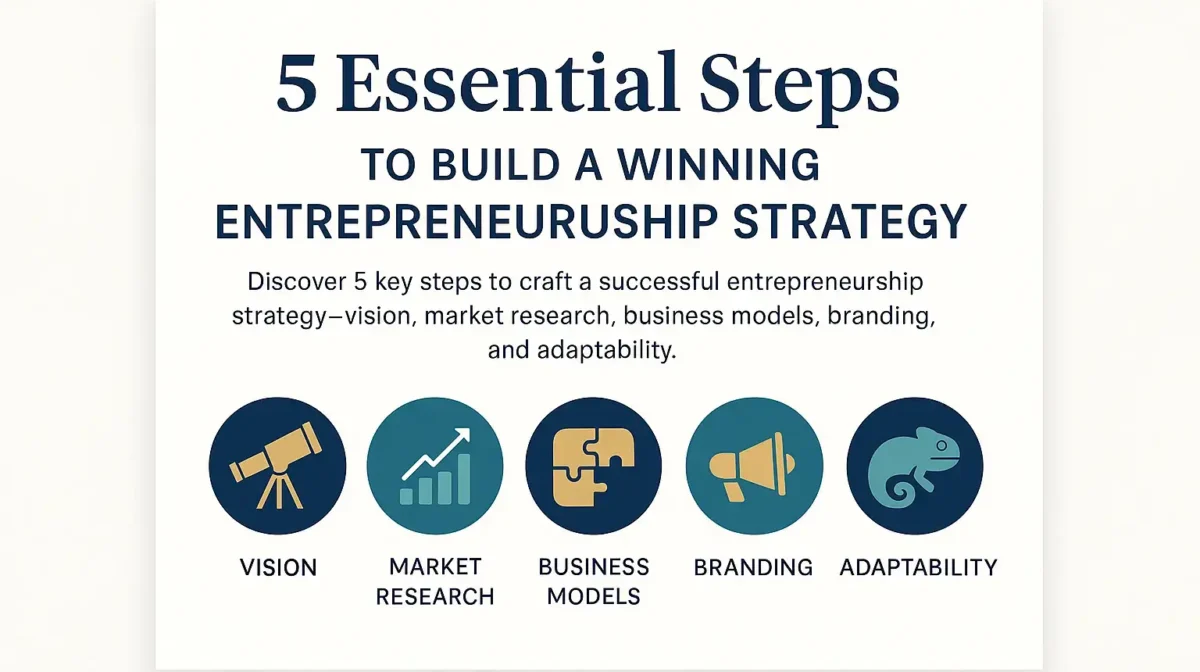5 Essential Steps to Build a Winning Entrepreneurship Strategy

Starting a business is more than just a big idea—it’s about turning that idea into a structured, sustainable strategy. Many entrepreneurs fail not because their concept lacked potential, but because they didn’t have a clear roadmap to guide their journey.
If you’re ready to turn your vision into a thriving business, here are five essential steps to help you craft an effective entrepreneurship strategy.
1. Define Your Vision and Mission
At the heart of every successful business lies a clear, strong vision and mission. Your vision defines your business’s future and paints the picture of your ideal goals—where your business is heading. Your mission explains the purpose of your business and how you plan to achieve these goals.
Start by asking yourself:
- What problem does my business solve?
- Who are my ideal target customers?
- What long-term impact do I want to create?
When you answer these questions, you’ll have a solid direction for your entrepreneurial journey and a strategy that aligns your values, team, and objectives.
2. Understand Your Market Inside Out
No business can thrive without a deep understanding of its market. Conduct thorough research on your industry, competitors, and target audience. Identify market gaps and find ways to offer unique value. Key actions include
- Analyzing industry trends and customer behavior
- Conducting surveys & interviews with potential customers through marketing focus groups
- Studying competitors to find their strengths and weaknesses
Use this with data analysis to identify what customers truly want. This enables you to deliver products or services that resonate with your target market and stand out from the competition.
3. Develop a Resilient & Flexible Business Model
A strong business model defines how your company delivers value and earns revenue. Consider:
- How will you solve customer pain points?
- What are your primary revenue streams?
- What are your fixed and variable costs?
- What are your value propositions for your customers?
Choose a model that fits your product and audience, whether it’s direct sales, subscriptions, freemium offers, or affiliate partnerships. A well-built business model provides the financial and operational backbone your startup needs to grow.
4. Build a Standout Brand and Marketing Strategy
Branding is essential for standing out in a crowded market. Your brand is more than just a logo; it’s the story, promise, and personality your audience connects with. It should communicate your values, mission, and unique selling proposition. To build a compelling brand:
- A memorable logo and tagline
- Consistent visual aesthetics and messaging
- A strong online presence, including a website and viral social media platforms
Once your brand identity is in place, develop a data-driven marketing strategy that includes content marketing, social media campaigns, influencer campaigns, SEO, email campaigns, WhatsApp campaigns, and paid advertising to reach and convert your ideal customers.
5. Focus on Execution and Adaptability
Execution transforms ideas into results. Set SMART goals (Specific, Measurable, Achievable, Relevant, Time-bound) and break them down into manageable tasks. Regularly review performance and optimize where needed.
But don’t forget, adaptability is just as important. The business landscape is constantly shifting. Stay responsive to market changes, listen to customer feedback, and remain open to refining your approach.
Conclusion
Building a successful business doesn’t have to be complicated. Success in entrepreneurship doesn’t require perfection. By following these five simple steps; Defining your vision, understanding your market, developing a strong business model, building a solid brand, and executing with adaptability, you can create an effective entrepreneurship strategy that leads to sustainable growth.
Stay committed, be persistent, adapt fast, and success will follow!






